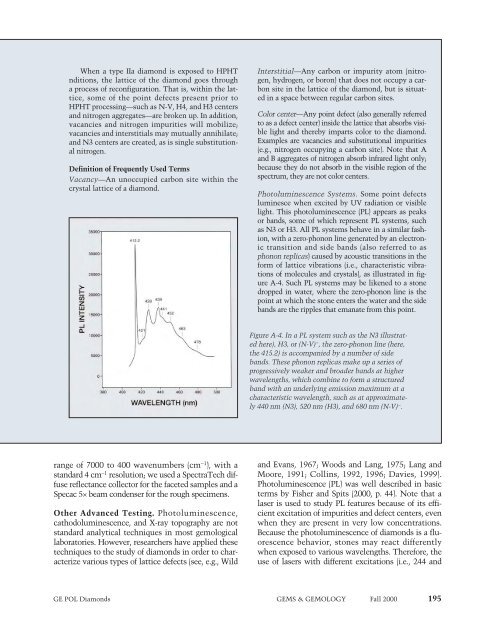Fall 2000 Gems & Gemology - Gemfrance
Fall 2000 Gems & Gemology - Gemfrance
Fall 2000 Gems & Gemology - Gemfrance
Create successful ePaper yourself
Turn your PDF publications into a flip-book with our unique Google optimized e-Paper software.
When a type IIa diamond is exposed to HPHT<br />
nditions, the lattice of the diamond goes through<br />
a process of reconfiguration. That is, within the lattice,<br />
some of the point defects present prior to<br />
HPHT processing—such as N-V, H4, and H3 centers<br />
and nitrogen aggregates—are broken up. In addition,<br />
vacancies and nitrogen impurities will mobilize;<br />
vacancies and interstitials may mutually annihilate;<br />
and N3 centers are created, as is single substitutional<br />
nitrogen.<br />
Definition of Frequently Used Terms<br />
Vacancy—An unoccupied carbon site within the<br />
crystal lattice of a diamond.<br />
range of 7000 to 400 wavenumbers (cm −1 ), with a<br />
standard 4 cm −1 resolution; we used a SpectraTech diffuse<br />
reflectance collector for the faceted samples and a<br />
Specac 5× beam condenser for the rough specimens.<br />
Other Advanced Testing. Photoluminescence,<br />
cathodoluminescence, and X-ray topography are not<br />
standard analytical techniques in most gemological<br />
laboratories. However, researchers have applied these<br />
techniques to the study of diamonds in order to characterize<br />
various types of lattice defects (see, e.g., Wild<br />
Interstitial—Any carbon or impurity atom (nitrogen,<br />
hydrogen, or boron) that does not occupy a carbon<br />
site in the lattice of the diamond, but is situated<br />
in a space between regular carbon sites.<br />
Color center—Any point defect (also generally referred<br />
to as a defect center) inside the lattice that absorbs visible<br />
light and thereby imparts color to the diamond.<br />
Examples are vacancies and substitutional impurities<br />
(e.g., nitrogen occupying a carbon site). Note that A<br />
and B aggregates of nitrogen absorb infrared light only;<br />
because they do not absorb in the visible region of the<br />
spectrum, they are not color centers.<br />
Photoluminescence Systems. Some point defects<br />
luminesce when excited by UV radiation or visible<br />
light. This photoluminescence (PL) appears as peaks<br />
or bands, some of which represent PL systems, such<br />
as N3 or H3. All PL systems behave in a similar fashion,<br />
with a zero-phonon line generated by an electronic<br />
transition and side bands (also referred to as<br />
phonon replicas) caused by acoustic transitions in the<br />
form of lattice vibrations (i.e., characteristic vibrations<br />
of molecules and crystals), as illustrated in figure<br />
A-4. Such PL systems may be likened to a stone<br />
dropped in water, where the zero-phonon line is the<br />
point at which the stone enters the water and the side<br />
bands are the ripples that emanate from this point.<br />
Figure A-4. In a PL system such as the N3 illustrated<br />
here), H3, or (N-V) − , the zero-phonon line (here,<br />
the 415.2) is accompanied by a number of side<br />
bands. These phonon replicas make up a series of<br />
progressively weaker and broader bands at higher<br />
wavelengths, which combine to form a structured<br />
band with an underlying emission maximum at a<br />
characteristic wavelength, such as at approximately<br />
440 nm (N3), 520 nm (H3), and 680 nm (N-V) − .<br />
and Evans, 1967; Woods and Lang, 1975; Lang and<br />
Moore, 1991; Collins, 1992, 1996; Davies, 1999).<br />
Photoluminescence (PL) was well described in basic<br />
terms by Fisher and Spits (<strong>2000</strong>, p. 44). Note that a<br />
laser is used to study PL features because of its efficient<br />
excitation of impurities and defect centers, even<br />
when they are present in very low concentrations.<br />
Because the photoluminescence of diamonds is a fluorescence<br />
behavior, stones may react differently<br />
when exposed to various wavelengths. Therefore, the<br />
use of lasers with different excitations (i.e., 244 and<br />
GE POL Diamonds GEMS & GEMOLOGY <strong>Fall</strong> <strong>2000</strong> 195


